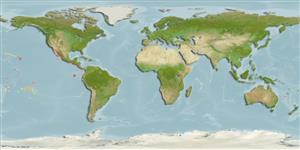Environment: milieu / climate zone / depth range / distribution range
Écologie
marin démersal; profondeur 0 - 45 m (Ref. 11482). Tropical
Eastern Pacific Ocean: from the Gulf of California and southwestern tip of Baja California northward to Bahia Santa Maria. Former subspecies D. pectoralis fallax (Mexico to Ecuador, including Cocos Island) and D. pectoralis insulatus (Revillagigedo Islands) in Ref. 11482 were elevated to species level.
Taille / Poids / Âge
Maturity: Lm ? range ? - ? cm
Max length : 5.2 cm TL mâle / non sexé; (Ref. 11482)
Distinguished from D. fallax and D. insulatus by having the following characters: scales absent above the lateral line; upper lip fimbriae, modally 9; preopercular canal pores, modally 5; unbranched labial fimbriae (Ref. 82814).
Found on sandy bottoms near reefs (Ref. 37955). Feeds on small fishes and invertebrates (Ref. 11482). Minimum depth from Ref. 58018.
Life cycle and mating behavior
Maturité | Reproduction | Frai | Œufs | Fécondité | Larves
Allen, G.R. and D.R. Robertson, 1994. Fishes of the tropical eastern Pacific. University of Hawaii Press, Honolulu. 332 p. (Ref. 11482)
Statut dans la liste rouge de l'IUCN (Ref. 130435: Version 2024-1)
Menace pour l'homme
Harmless
Utilisations par l'homme
Outils
Articles particuliers
Télécharger en XML
Sources Internet
Estimates based on models
Preferred temperature (Ref.
123201): 20.6 - 28.4, mean 24.7 °C (based on 56 cells).
Phylogenetic diversity index (Ref.
82804): PD
50 = 0.5000 [Uniqueness, from 0.5 = low to 2.0 = high].
Bayesian length-weight: a=0.00389 (0.00180 - 0.00842), b=3.12 (2.94 - 3.30), in cm total length, based on all LWR estimates for this body shape (Ref.
93245).
Niveau trophique (Ref.
69278): 4.0 ±0.61 se; based on food items.
Fishing Vulnerability (Ref.
59153): Low vulnerability (10 of 100).
